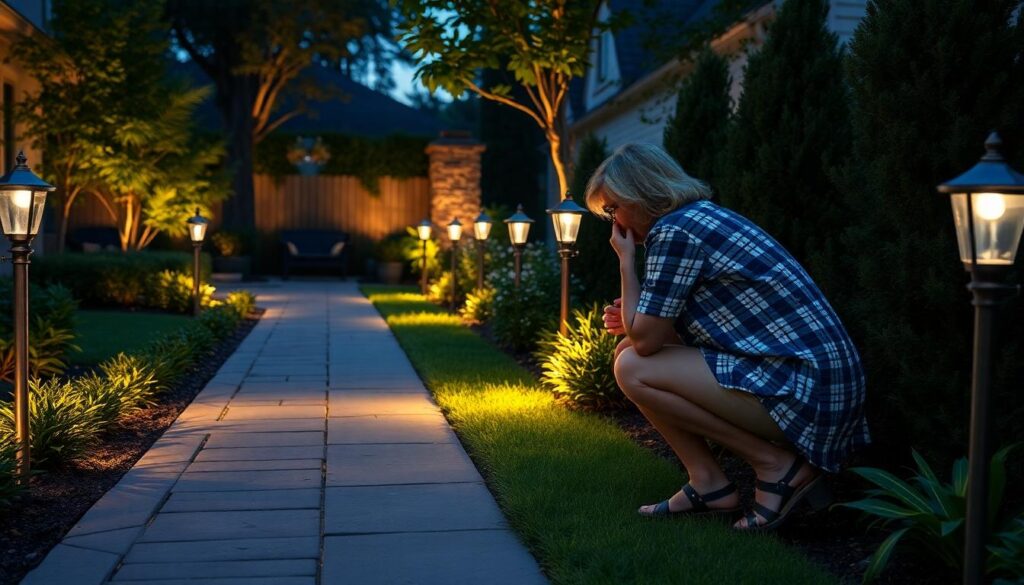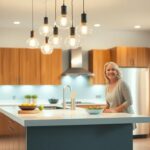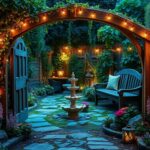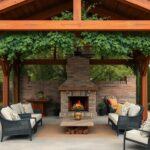Outdoor lighting transforms your home’s exterior, creating ambiance while improving safety and security. Yet many homeowners unknowingly make critical mistakes that diminish the effectiveness of their lighting investments. From improper placement to neglecting energy efficiency, these errors can leave your outdoor spaces looking amateur rather than amazing.
We’ve seen countless beautiful homes with outdoor lighting that falls short of its potential. Whether you’re planning a new installation or looking to upgrade your existing setup, avoiding common pitfalls will save you time, money, and frustration. In this guide, we’ll walk through the biggest outdoor lighting mistakes and show you practical answers to illuminate your property like a professional.
10 Biggest Outdoor Lighting Mistakes Homeowners Make
1. Overlooking proper planning
Proper planning sets the foundation for successful outdoor lighting. Many homeowners rush into installing fixtures without considering their overall design goals. Before purchasing any equipment, take time to evaluate your space and determine what areas need illumination. Create a lighting plan that addresses key elements like pathways, architectural features, and industry focal points. This approach ensures your lighting serves both functional and aesthetic purposes rather than appearing random or disjointed.
2. Installing fixtures at the wrong height
Fixture placement significantly impacts the effectiveness of your outdoor lighting. Mounting lights too high or too low can create harsh shadows or inadequate illumination. Path lights should typically stand 14-18 inches above ground, while wall sconces generally work best at eye level or slightly above. Security lights should be positioned high enough to cover the intended area but not so high that they lose intensity where needed. Proper height placement creates balanced lighting that enhances your outdoor space without causing glare or dark spots.
3. Creating light pollution
Excessive brightness can actually diminish the appeal of your outdoor space and disturb neighbors. Many homeowners mistakenly believe that brighter always means better when it comes to outdoor lighting. Unshielded fixtures that spread light in all directions contribute to light pollution and waste energy. Choose fixtures with shields or downward-facing designs that direct light precisely where needed. This targeted approach creates a more pleasant atmosphere while being considerate to your neighborhood’s night environment.
4. Forgetting about maintenance
Maintenance plays a crucial role in preserving your outdoor lighting’s effectiveness. Neglected fixtures quickly become eyesores as they collect dirt, develop rust, or become obscured by growing vegetation. Establish a regular maintenance schedule to clean fixtures, replace bulbs, and check for damage from weather exposure. Solar lights particularly require clear panels to charge effectively. Well-maintained lighting not only looks better but also functions more efficiently and lasts longer, protecting your investment.
5. Using the wrong color temperature
Color temperature dramatically affects the mood and functionality of your outdoor spaces. Many homeowners select lighting with inappropriate color temperatures that clash with their home’s aesthetic. Warm white light (2700K-3000K) creates inviting, cozy environments ideal for entertainment areas. Cooler temperatures (4000K-5000K) work better for security purposes or highlighting exact industry features. Consider your home’s architectural style and exterior colors when selecting light temperatures to create a cohesive look throughout your property.
6. Ignoring energy efficiency
Energy efficiency considerations can save substantial money over time with outdoor lighting. Traditional incandescent bulbs waste energy and require frequent replacement, yet many homeowners still use them out of habit. LED options now provide superior illumination while using up to 80% less energy and lasting 25 times longer than incandescent alternatives. Solar-powered fixtures eliminate electricity costs entirely for appropriate applications. Investing in energy-efficient lighting reduces both your environmental impact and long-term operating expenses.
7. Poor distribution of light
Even distribution creates harmony in outdoor lighting design. Focusing too much light in some areas while neglecting others creates an unbalanced look that diminishes your property’s appeal. Strategic placement of various fixture types ensures proper coverage throughout your industry. Mix ambient, task, and accent lighting to achieve multiple layers that provide both functionality and visual interest. This layered approach creates depth and dimension that enhances your outdoor living spaces during evening hours.
8. Choosing fixtures that don’t match architectural style
Fixture style compatibility strengthens your home’s aesthetic appeal. Selecting lights without considering your home’s architectural design often leads to a disjointed appearance. Mediterranean-style homes pair beautifully with wrought iron fixtures, while contemporary houses complement sleek, minimalist designs. Victorian properties benefit from classic lantern styles that honor their historical character. Choose fixtures that extend your home’s architectural language into the industry for a unified and thoughtful appearance.
9. Neglecting safety considerations
Safety should remain a top priority in outdoor lighting design. Inadequate illumination of steps, changes in elevation, or walkways creates hazardous conditions for family members and guests. Properly light all transitional areas, especially those with potential tripping hazards. Ensure that electrical connections remain protected from moisture and that low-voltage systems are properly installed. Well-executed safety lighting blends seamlessly with decorative elements while providing essential visibility that prevents accidents.
10. DIY installation without proper knowledge
Professional installation ensures optimal performance and safety of your outdoor lighting system. Many homeowners attempt DIY installation without understanding electrical requirements or proper fixture positioning. Improperly installed systems can create fire hazards, premature fixture failure, or insufficient lighting coverage. Consulting with lighting professionals helps you avoid common pitfalls and ensures your system meets local codes. Their expertise allows for proper placement, appropriate voltage considerations, and weatherproof connections that maximize both safety and visual impact.
Overlooking the Importance of a Lighting Plan

Many homeowners rush into outdoor lighting projects without proper planning, leading to disappointing results and wasted resources. A comprehensive lighting plan serves as the foundation for any successful outdoor illumination project.
Insufficient Design Planning
Jumping straight into installation without a clear design strategy often results in uneven lighting distribution throughout your property. We find that homeowners who skip the planning phase frequently end up with areas that are either too bright or too dark, creating an imbalanced look. Your outdoor spaces deserve thoughtful consideration of how light will interact with architectural features, landscaping elements, and functional areas.
Selecting inappropriate fixtures compounds this problem significantly. Using path lights to illuminate building facades or flood lights for delicate garden features creates jarring visual effects that detract from your home’s appearance. Each lighting fixture type serves a exact purpose, and understanding these distinctions forms a crucial part of effective planning.
Failing to Consider Different Zones
Creating proper layered lighting requires thinking about your outdoor space in distinct functional zones. We notice that properties with flat, uniform lighting lack dimension and fail to showcase the depth and texture of landscaping features. Incorporating a mix of path lights, wall-mounted fixtures, and uplights creates visual interest through layered illumination that brings your industry to life.
Zone consideration extends beyond aesthetics to functionality. Front entrances require different lighting approaches than backyard entertainment areas or security-focused perimeter lighting. Without zonal planning, light often spills unintentionally between areas, creating unwanted brightness in relaxation spaces or insufficient illumination in high-traffic areas. Planning for how these zones interact ensures each outdoor area serves its intended purpose while maintaining visual harmony.
Skipping Professional Consultation
Consulting with lighting professionals can prevent costly mistakes that many homeowners discover only after installation. Experts bring valuable knowledge about fixture placement, light distribution patterns, and technical requirements that DIY enthusiasts typically lack. We’ve seen many cases where homeowners needed to completely reinstall systems due to fundamental planning errors that could have been avoided with professional input.
Power supply considerations represent another critical aspect that professionals address during planning. Inadequate electrical planning leads to overloaded circuits, insufficient brightness, or systems that fail prematurely. Lighting professionals ensure your system has appropriate power distribution, weatherproofing, and circuit protection to operate safely and effectively. Their expertise also helps navigate local building codes and regulations that govern outdoor electrical installations, preventing potential legal and safety issues down the road.
Installing Fixtures That Are Too Small
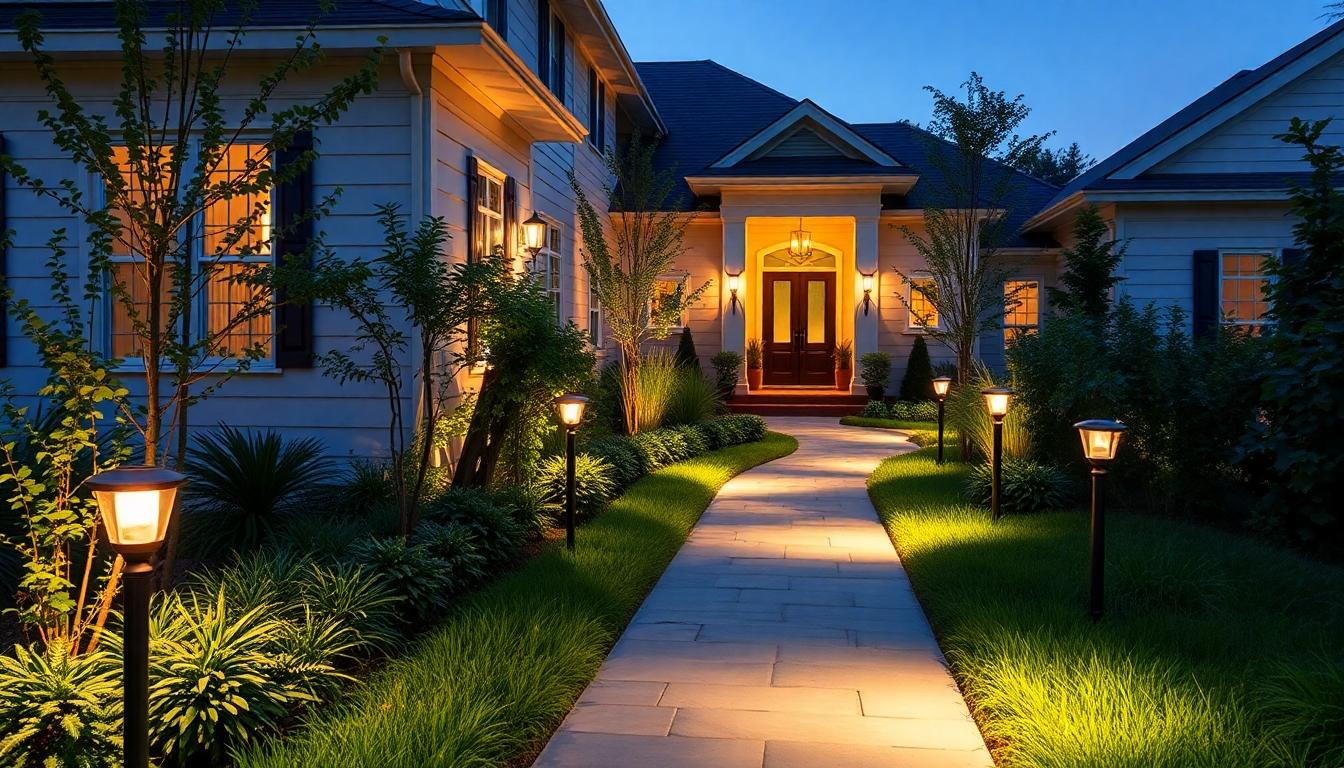
Choosing undersized lighting fixtures is one of the most common mistakes homeowners make when designing outdoor lighting. When fixtures are too small for the space or architectural elements they’re meant to illuminate, both functionality and aesthetics suffer significantly.
Underestimating Scale Requirements
Scale miscalculations lead to inadequate illumination and visually unbalanced exteriors. Large architectural features paired with tiny fixtures create a disproportionate look that diminishes your home’s appeal. Spatial dimensions often go unconsidered in lighting plans, resulting in patchy coverage and dark zones throughout your outdoor areas. Professional designers recommend alternating fixture placement in a zig-zag pattern for pathways rather than creating an “airport runway” effect with straight lines. This approach maintains necessary visibility while creating a more natural lighting flow. Proper scaling ensures light distributes effectively across your space while complementing your home’s architectural elements.
Choosing Decorative Over Functional Lighting
The allure of decorative fixtures can overshadow practical lighting needs, creating beautiful but ineffective outdoor spaces. Pathway lights must prioritize safety and visibility over purely ornamental qualities, especially in areas with steps or uneven terrain. Functional fixtures like well-lights and spotlights require strategic, discreet placement to highlight features without producing uncomfortable glare for visitors. Many homeowners select fixtures based solely on daytime appearance without considering their nighttime performance. Task-oriented areas such as patios, outdoor kitchens, and entryways demand adequate illumination that decorative-only fixtures typically cannot provide. Balancing form and function allows us to create outdoor spaces that are both visually stunning and practically usable after dark.
Forgetting About Light Pollution
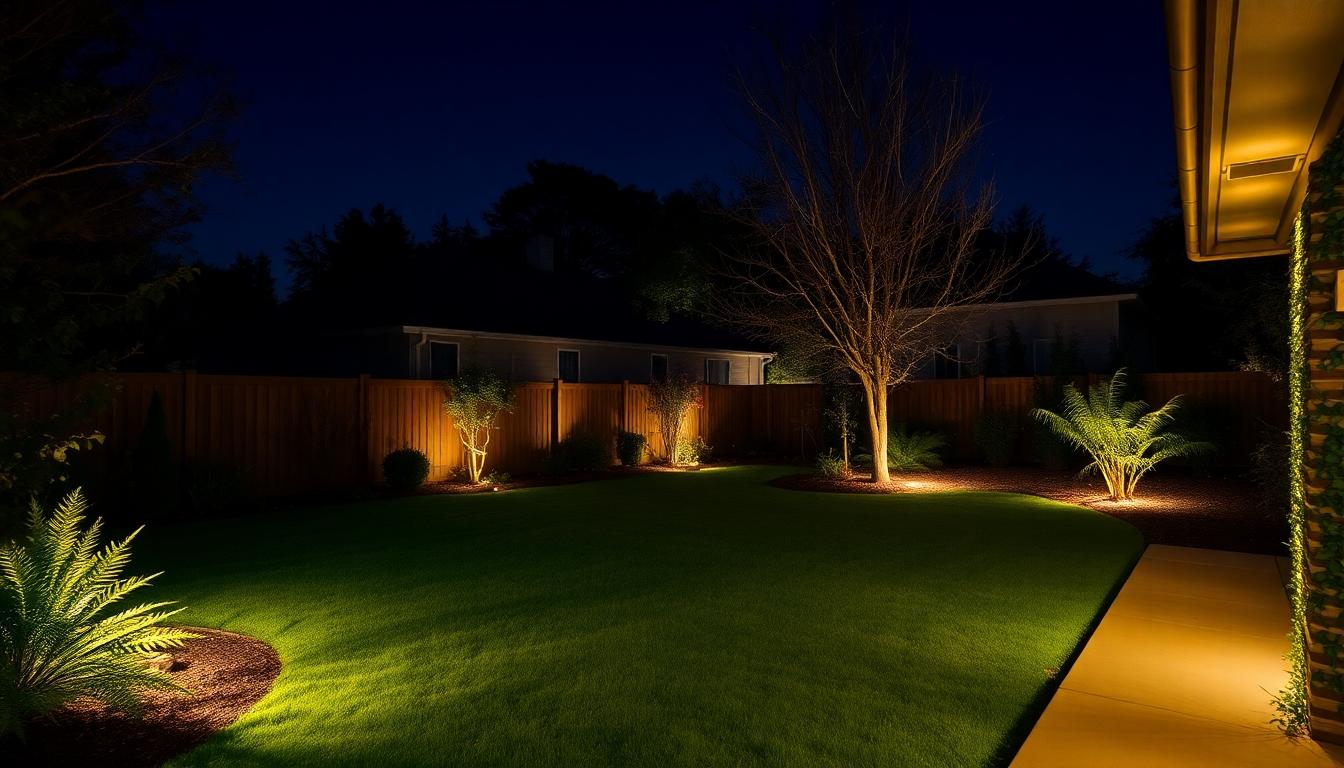
Light pollution is one of the most overlooked aspects of outdoor lighting design that can have far-reaching consequences. Many homeowners focus solely on aesthetics without considering how their lighting choices affect the environment and community around them.
Creating Unwanted Glare
Unwanted glare is a serious problem that stems from incorrect fixture placement and excessive brightness levels. Poorly positioned lighting can create harsh, uncomfortable visibility conditions that impact both residents and passersby. Fixtures that shine directly into viewing angles rather than illuminating intended targets waste energy and create visual discomfort. Many homeowners make the mistake of installing high-intensity lights without proper shielding or directional control, resulting in light that scatters inefficiently instead of focusing where needed. Proper fixture selection with built-in glare control features can significantly reduce this issue while maintaining effective illumination. Adjusting the angle and height of lights to direct them downward rather than outward or upward helps minimize glare while still providing necessary visibility.
Disrupting Wildlife and Neighbors
Bright outdoor lighting can have important negative impacts on both local wildlife and your neighborhood community. Excessive illumination disrupts natural nocturnal rhythms for animals, affecting feeding, mating, and migration patterns essential to local ecosystems. Birds, in particular, can become disoriented by bright nighttime lighting, sometimes with fatal consequences during migration seasons. Your neighbors may experience sleep disturbances when your outdoor lights shine into their windows or create an overwhelming brightness in shared spaces. Thoughtful placement and intensity adjustment are critical steps to minimize these impacts while still maintaining functional lighting. Using motion sensors, timers, and dimmers allows lights to activate only when needed, reducing continuous illumination that disturbs wildlife habitats. Warm color temperatures (2700-3000K) typically create less disruption to both humans and animals compared to harsh blue-white lighting that mimics daylight. Considering the direction and spread of light ensures illumination stays within your property boundaries rather than spilling over to natural areas or neighboring homes.
Neglecting Energy Efficiency Options
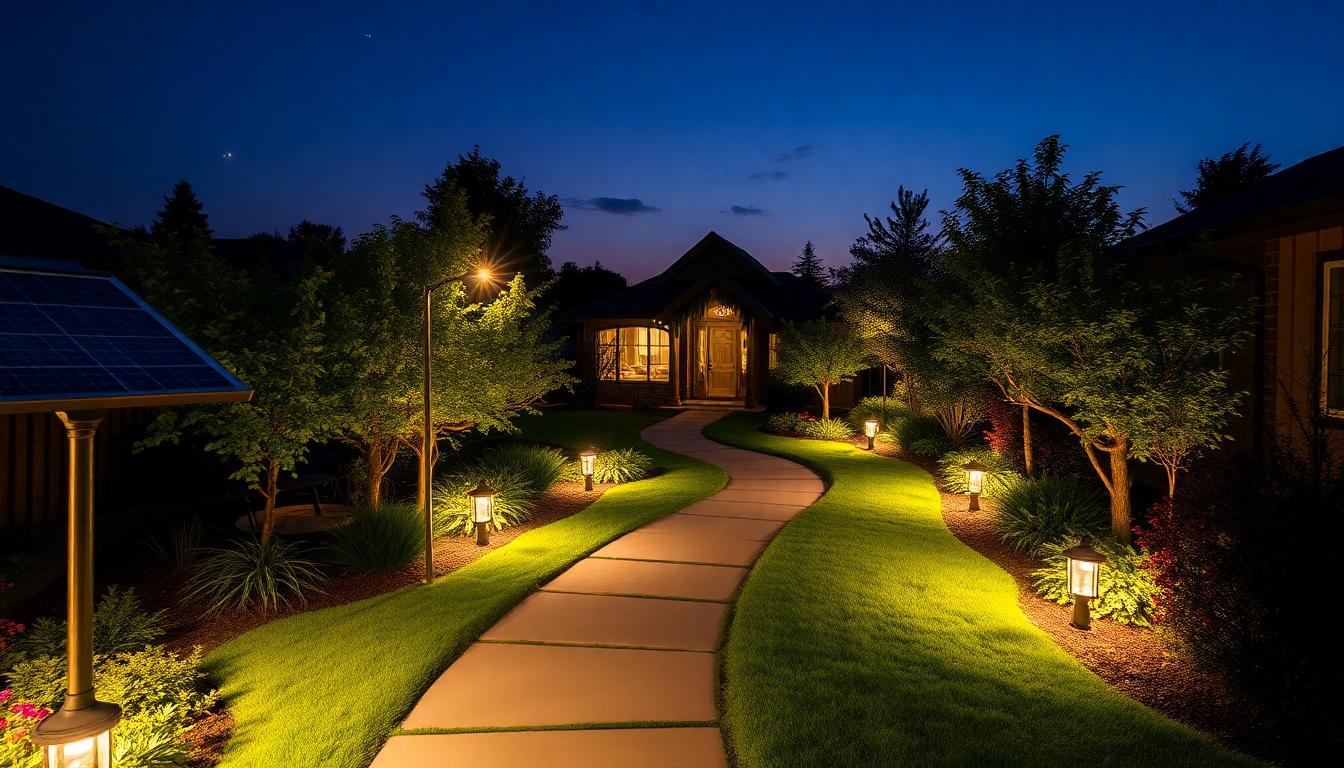
One of the most common mistakes homeowners make with outdoor lighting is overlooking energy-efficient options. Traditional lighting answers can unnecessarily drain your wallet while harming the environment. Let’s explore how to avoid these costly oversights.
Missing Opportunities for Solar Lighting
Solar-powered fixtures represent a important opportunity that many homeowners fail to capitalize on when designing their outdoor lighting. These eco-friendly options eliminate the need for complex wiring, substantially reducing installation complexity and associated costs. By bypassing solar lighting, homeowners subject themselves to higher electricity bills and unnecessary grid dependence when free energy is readily available. Solar lights work exceptionally well for illuminating pathways, gardens, and accent areas where electrical access might be challenging. They harness daylight to power nighttime illumination, providing a sustainable solution that continues working during power outages. We’ve found that strategic placement of solar fixtures can transform outdoor spaces while maintaining a commitment to environmental responsibility.
Ignoring LED Technology Benefits
LED lighting technology offers superior benefits that many homeowners overlook, resulting in inefficient outdoor lighting systems. LEDs consume up to 80% less energy than traditional halogen bulbs, creating immediate and substantial savings on electricity costs. The extended lifespan of LED fixtures—often lasting 15-25 times longer than incandescent alternatives—drastically reduces maintenance requirements and replacement frequency. Homeowners who avoid LEDs find themselves repeatedly purchasing new bulbs and spending valuable time on unnecessary maintenance. Another advantage of LED technology is its superior color temperature control, allowing you to avoid overly harsh or excessively warm lighting that can detract from your property’s appearance. These fixtures also perform better in extreme weather conditions, maintaining brightness and efficiency regardless of outdoor temperatures. We recommend conducting an energy audit of your current lighting system to identify opportunities for LED upgrades that will optimize both fixture quantity and placement for maximum efficiency.
Using Incorrect Brightness Levels
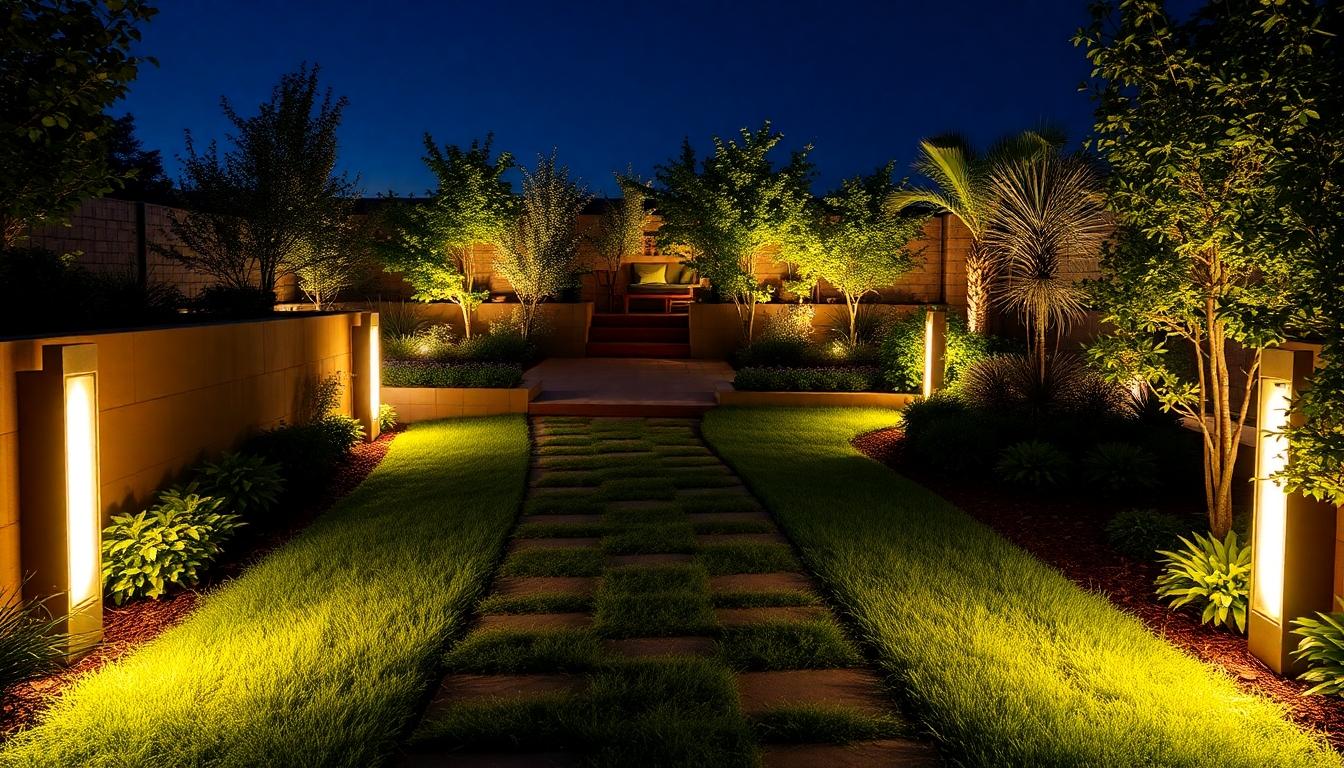
Finding the perfect balance of brightness in your outdoor lighting design can be challenging. Many homeowners either overdo it with excessive illumination or underlight important areas, both of which can compromise the effectiveness of your outdoor lighting system.
Installing Lights That Are Too Bright
Excessively bright outdoor lighting creates an uncomfortable glare that can ruin the aesthetic appeal of your property. This common mistake often results from what lighting professionals call “lighting overkill” – installing too many fixtures in a small area or using bulbs with unnecessarily high wattage. Overly bright lights not only waste energy but also create harsh shadows that can make your outdoor space feel unwelcoming. Powerful floodlights pointed in the wrong direction can blind visitors and create safety hazards rather than improving security. Neighbors might also be affected by your overly bright lights, potentially causing relationship tensions in your community. We recommend using dimmers or selecting fixtures with appropriate brightness levels to create a more subtle, sophisticated lighting effect that highlights your property’s best features without overwhelming them.
Using Insufficient Illumination in Critical Areas
Inadequate lighting in essential areas like pathways, steps, and entryways poses important safety and security risks. Proper illumination of these zones is crucial for preventing trips, falls, and other accidents, especially when guests are unfamiliar with your property’s layout. Path lights should be spaced approximately 8-10 feet apart to provide consistent illumination without creating a “runway” effect. Entry points require particular attention, as they’re both important for security and serve as focal points for your home’s exterior appearance. Driveways benefit from subtle lighting that guides vehicles safely while complementing your overall design scheme. Outdoor living spaces such as patios and decks need sufficient light for activities without being uncomfortably bright. We’ve found that layering different types of lighting—combining path lights with spotlights or wall sconces—creates the most effective illumination for critical areas while maintaining visual interest.
Mismatching Lighting Styles With Architecture
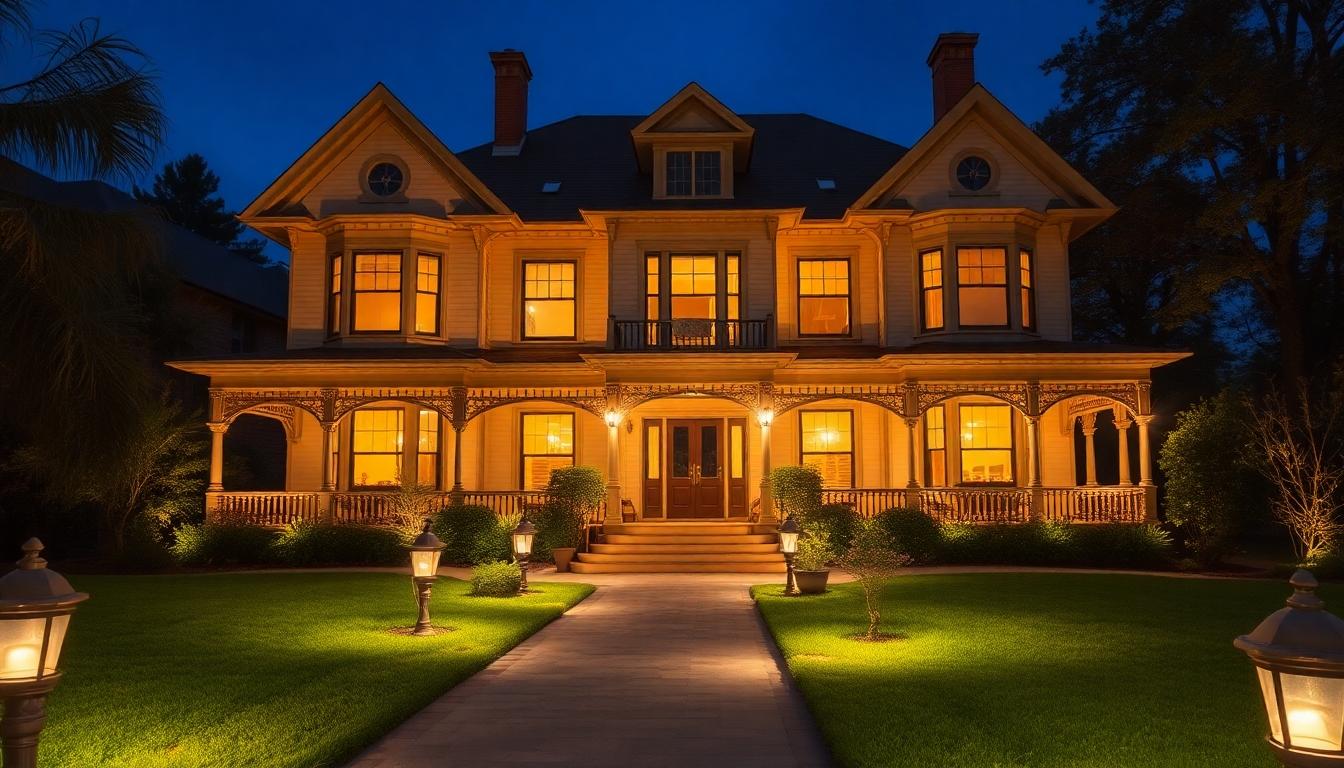
One of the most jarring outdoor lighting mistakes we see is fixtures that clash with a home’s architectural style. This disconnect creates visual discord that can undermine your entire exterior design.
Mixing Incompatible Design Elements
Using conflicting lighting types creates an immediate sense of disharmony in your outdoor spaces. When you combine warm and cool color temperatures within the same area, the resulting visual tension makes your property look unplanned and amateur. Overlapping beams from excessive fixtures generate glare and create uneven illumination patterns across your yard. We’ve noticed that poorly spaced path lights often exacerbate this problem, creating patches of brightness and darkness rather than consistent illumination. Unbalanced uplighting can also contribute to unwanted “light pollution” that eventually detracts from focal points like gardens or decorative walkways. For best results, maintain consistency in fixture styles, light color temperature, and illumination patterns throughout your property.
Overlooking Historical Context
Ignoring your property’s historical integrity can significantly diminish its authentic appeal and character. Installing harsh LED flood lights on a vintage façade immediately breaks the visual harmony that makes historical properties special. Period-appropriate fixtures make an enormous difference—for example, gas-lamp replicas complement Victorian homes perfectly, while warmer color temperatures between 2700K and 3000K preserve aesthetic continuity across historical structures. Poor placement compounds these problems, particularly when upward-facing spotlights miss key architectural details they’re meant to highlight. We recommend researching your home’s original lighting styles or consulting with a designer who specializes in historical properties. Modern lighting innovations can still be integrated sensitively, using fixtures that honor your home’s architectural heritage while providing contemporary performance.
Improper Placement of Path Lighting
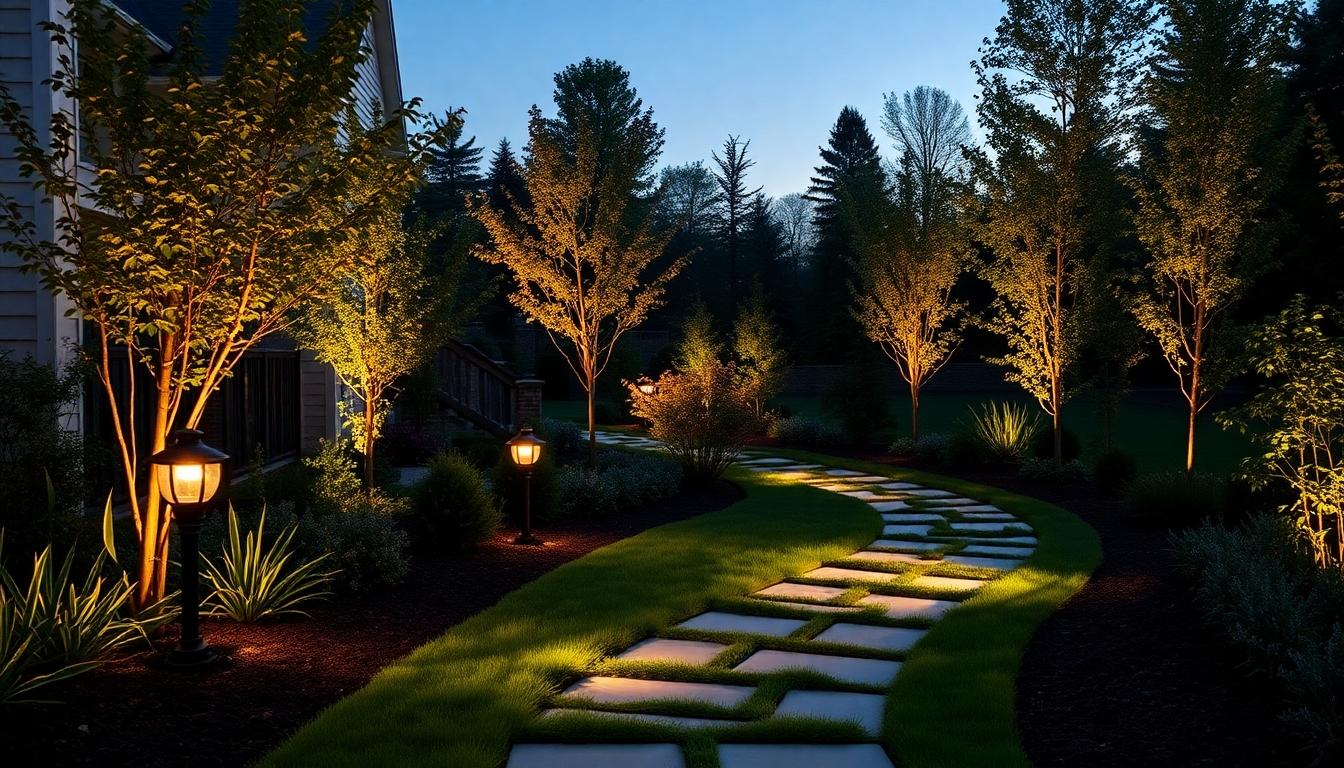
Path lighting serves as both a safety feature and design element for your outdoor spaces. Incorrect placement can compromise both functionality and aesthetic appeal, leading to ineffective illumination and potential hazards.
Spacing Fixtures Too Far Apart
Placing path lights with excessive distance between them creates problematic dark spots throughout your walkways. Many homeowners make the critical mistake of trying to save money by installing fewer fixtures, resulting in uneven lighting that fails to guide visitors safely. Professional landscapers recommend spacing fixtures no more than 6-8 feet apart to maintain consistent illumination across pathways. Balanced distribution ensures both safety and visual continuity, preventing the jarring effect of alternating bright spots and shadows. Too many dark zones can make navigation difficult at night, increasing the risk of trips and falls on uneven terrain.
Positioning Lights at the Wrong Height
Fixture height plays a crucial role in effective path lighting performance and longevity. Lights mounted too high fail to properly illuminate the walking surface, creating diffused light that doesn’t adequately show steps or pathway edges. Conversely, fixtures positioned too low become vulnerable to physical damage from lawn equipment, foot traffic, or adverse weather conditions. Optimal path light height typically ranges between 14-18 inches above ground level, providing sufficient downward illumination without creating glare for pedestrians. We’ve found that properly positioned fixtures not only enhance safety but also create appealing light patterns that showcase surrounding industry features. Adjustable-height options offer flexibility for different pathway applications while maintaining consistent light quality throughout your outdoor space.
Failing to Consider Weather Resistance
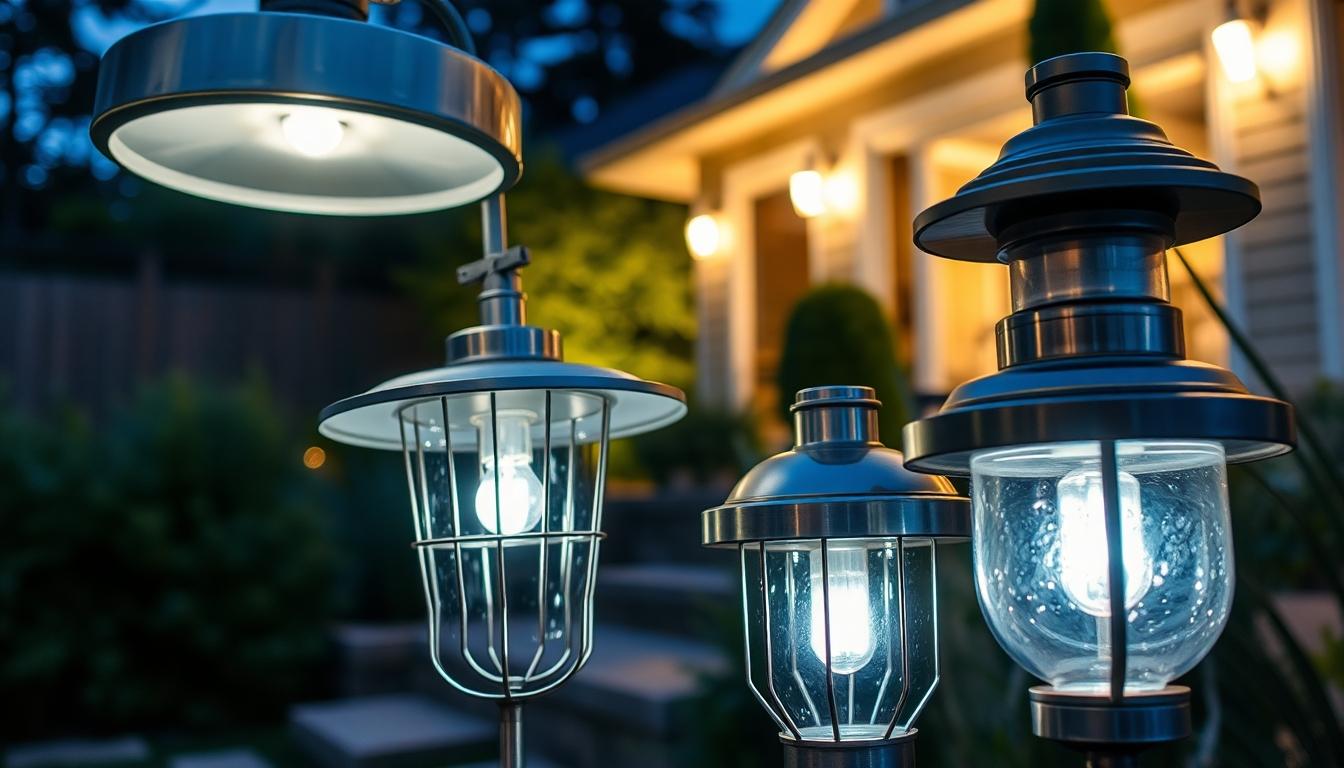
One of the most costly mistakes homeowners make is using indoor-rated fixtures in outdoor spaces. This oversight not only leads to premature fixture failure but also creates serious safety hazards that could have been easily avoided.
Choosing the Wrong IP Rating
IP (Ingress Protection) ratings are crucial indicators of how well a lighting fixture can withstand environmental exposure. Many homeowners select fixtures with inadequate IP ratings for their exact outdoor conditions, resulting in electrical failures and short circuits. Fixtures installed near pools, water features, or in areas with direct rainfall require higher ratings such as IP65 or IP67 to ensure proper protection. Lower-rated fixtures exposed to moisture will inevitably suffer from water ingress, creating dangerous electrical hazards and requiring frequent replacement. We recommend carefully matching your fixture’s IP rating to its exact installation environment, with nothing less than IP65 for fixtures that will experience direct weather exposure.
Neglecting Material Durability
The materials used in outdoor lighting fixtures significantly impact their longevity and performance. Cheap plastic housings and substandard metals quickly degrade when exposed to UV radiation, temperature fluctuations, and persistent moisture. Marine-grade aluminum and stainless steel offer superior corrosion resistance and maintain their integrity even in harsh outdoor conditions. UV-stable finishes provide an additional layer of protection that prevents discoloration and deterioration over time. Investing in fixtures constructed from high-quality, weather-resistant materials will dramatically extend their lifespan and reduce maintenance costs. We always advise our clients to examine the material specifications before purchasing outdoor fixtures, as this simple step can prevent disappointment and unnecessary replacements down the road.
Ignoring Maintenance Requirements
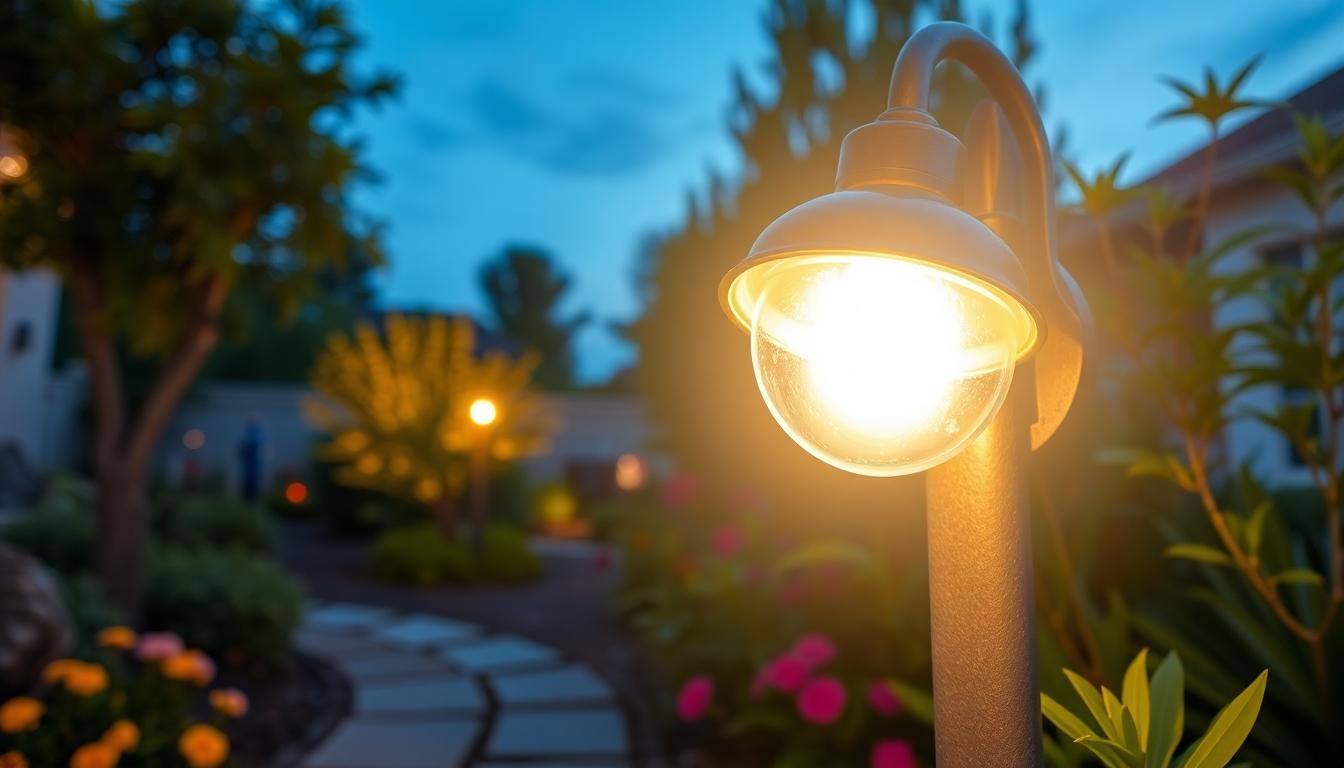
Outdoor lighting systems require consistent upkeep to maintain their functionality and appearance. Neglecting maintenance can dramatically reduce the effectiveness of even the most expensive lighting installations.
Forgetting About Regular Cleaning Needs
Regular cleaning of outdoor lighting fixtures is essential for maintaining optimal illumination. Dirt, debris, and environmental residue can accumulate on lenses and housings, significantly diminishing light output over time. Studies show that failing to clean fixtures periodically can reduce their effectiveness by up to 30% within just a few months. Insects, pollen, and dust build-up create a film that blocks light and creates uneven distribution patterns across your industry. We recommend establishing a quarterly cleaning schedule for all outdoor fixtures, using a mild soap solution and soft cloth to prevent scratching delicate surfaces. Fixtures in areas with heavy tree coverage or near water features typically require more frequent attention due to increased exposure to environmental elements.
Overlooking Replacement Part Availability
Many homeowners fail to consider replacement part availability when selecting outdoor lighting systems. Before installing any fixtures, research whether replacement components like bulbs, lenses, and housings will remain accessible throughout the product’s expected lifespan. Proprietary fixtures from smaller manufacturers might offer unique designs but can become maintenance nightmares when parts become unavailable. Industry experts recommend selecting lighting from established brands with proven track records of supporting their products long-term. Stocking essential spare parts such as bulbs and gaskets prevents extended periods of non-functioning lights when failures occur. Remember that weather exposure accelerates wear on outdoor fixtures, making replacement needs inevitable rather than optional. Systems with modular components generally offer greater long-term serviceability compared to integrated designs where a single failure might require replacing the entire fixture.
How to Avoid These Common Outdoor Lighting Mistakes
Creating beautiful outdoor lighting doesn’t have to be complicated. By avoiding the mistakes we’ve outlined you’ll enhance your home’s appearance safety and value while saving money long-term.
Remember to prioritize planning before purchasing fixtures match styles to your architecture’s character and select appropriate brightness levels for each area. Choose quality weather-resistant materials with proper IP ratings and establish a regular maintenance routine.
For best results consider consulting with a lighting professional who can help navigate technical requirements while ensuring your vision comes to life. With thoughtful design and proper implementation your outdoor lighting will create the perfect ambiance while providing essential functionality for years to come.
Frequently Asked Questions
What are the most common outdoor lighting mistakes homeowners make?
The most common mistakes include improper planning, incorrect fixture height, creating light pollution, poor maintenance, using wrong color temperatures, ignoring energy efficiency, poor light distribution, choosing mismatched fixtures, neglecting safety considerations, and attempting DIY installation without proper knowledge. These mistakes can compromise both the functionality and aesthetic appeal of outdoor lighting systems.
How far apart should pathway lights be placed?
Pathway lights should be spaced no more than 6-8 feet apart to ensure consistent illumination without dark spots. The optimal height for these fixtures is 14-18 inches above ground level. For maximum effectiveness, consider installing them in a zig-zag pattern rather than in straight lines on both sides, which provides better coverage and creates a more pleasing visual effect.
Why is it important to use outdoor-rated fixtures?
Using indoor fixtures outdoors can lead to premature failure and serious safety hazards. Outdoor fixtures should have appropriate IP (Ingress Protection) ratings to withstand environmental exposure, especially moisture. For direct weather exposure, choose fixtures with a minimum IP65 rating. This ensures electrical safety and longevity of your lighting system even in harsh conditions.
How can I prevent light pollution from my outdoor lighting?
To prevent light pollution, use fixtures with shields or downward-facing designs that direct light where needed, install motion sensors so lights only activate when necessary, opt for warm color temperatures (2700-3000K), use dimmers to reduce brightness when full intensity isn’t needed, and consider “dark sky friendly” fixtures specifically designed to minimize light scatter and upward glow.
What’s the best type of lighting for energy efficiency?
LED lighting is the most energy-efficient option for outdoor lighting, using up to 80% less energy than traditional bulbs while lasting significantly longer. Solar-powered fixtures offer additional benefits by eliminating wiring needs and operating costs. Consider conducting an energy audit of your current system to identify opportunities for LED upgrades and optimize efficiency while maintaining effective illumination.
How do I match outdoor lighting to my home’s architecture?
Select fixtures that complement your home’s architectural style and period. For contemporary homes, choose clean-lined, minimalist fixtures; for traditional homes, consider lantern-style or classical designs. Maintain consistency in design elements and color temperatures throughout your property. For historic homes, research period-appropriate fixtures or consult with designers specializing in historical properties.
What materials are best for outdoor lighting fixtures?
Choose fixtures made from durable, weather-resistant materials such as marine-grade aluminum, brass, copper, or stainless steel. These materials withstand environmental exposure without corroding or deteriorating. Quality fixtures may cost more initially but save money long-term by requiring fewer replacements. Always check material specifications before purchasing to ensure suitability for your climate and conditions.
How important is maintenance for outdoor lighting systems?
Regular maintenance is crucial for outdoor lighting effectiveness. Establish a cleaning schedule to remove dirt and debris that can block light output. Check for damaged wires, loose connections, and water infiltration. Replace bulbs proactively before they fail completely. Choose established brands that offer replacement parts and long-term support to avoid future maintenance challenges.
Should I prioritize decorative or functional lighting for my outdoor spaces?
While decorative lighting enhances aesthetics, functional lighting should be your priority, especially in areas with steps, uneven terrain, or potential hazards. The best approach is a balanced combination: start with essential lighting for safety and visibility, then add decorative elements to highlight architectural features and create ambiance. This layered approach ensures your lighting is both practical and beautiful.
Is it worth hiring a professional for outdoor lighting installation?
Professional installation is often worth the investment, especially for complex systems requiring electrical work. Professionals bring expertise in fixture placement, power supply requirements, and compliance with local regulations. They can create comprehensive lighting plans that optimize both function and aesthetics while avoiding common mistakes. For simple projects, DIY may be appropriate, but consult with experts for more extensive lighting systems.

